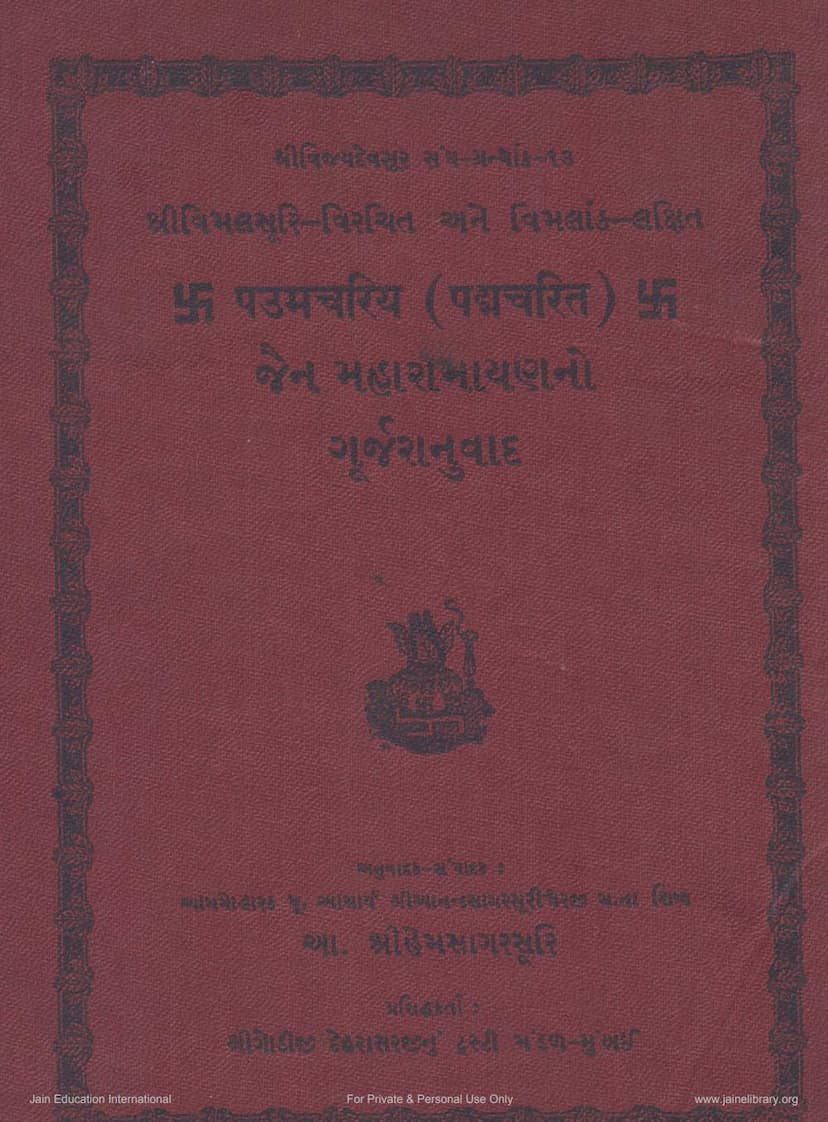Paumchariya
Added to library: September 2, 2025

Summary
Certainly! Based on the provided text, here is a comprehensive summary of the Jain text "Paumchariya" by Hemsagarsuri:
Paumchariya: A Jain Retelling of the Ramayana
The book "Paumchariya" (also referred to as "Padmcharitra" or "Jain Mahararamayana") is a significant Jain work attributed to Acharya Vimlasuri, believed to have been composed around 530 years after the Nirvana of Bhagwan Mahavir (approximately Vikram Samvat 60). This summary is based on the Gujarati translation and commentary by Acharya Hemsagarsuri, published by Shri Godiji Jain Derasar, Mumbai.
Core Narrative and Significance:
"Paumchariya" retells the epic story of Rama, presented within the Jain framework. The text emphasizes Jain principles, offering a moral and spiritual perspective on the events and characters familiar from the traditional Ramayana. It highlights themes of dharma, detachment, karma, compassion, and the ultimate attainment of liberation. The narrative is rich in descriptions of customs, rituals, ethical teachings, philosophical insights, and the path to renunciation and spiritual purity.
Key Features and Content:
- Jain Interpretation: The text systematically reinterprets the Ramayana narrative to align with Jain philosophy. Actions and motivations of characters are often viewed through the lens of karma, past lives, and the pursuit of liberation (moksha).
- Purity of Characters: Jain tradition often portrays characters like Rama and Sita in a more virtuous light, free from the morally ambiguous actions sometimes attributed to them in other versions. The "Paumchariya" likely adheres to this, presenting a purified version of the epic.
- Moral and Ethical Teachings: The text is replete with moral instructions, showcasing the consequences of virtuous and non-virtuous actions. It emphasizes the importance of non-violence (ahimsa), truthfulness, non-stealing, celibacy, and non-possession.
- Spiritual Path: It details the spiritual journeys of various characters, including their renunciation, austerities, and eventual attainment of liberation. The emphasis is on self-control and the shedding of karmic bondage.
- Vimlasuri's Introduction: The original author, Vimlasuri, states that he composed this work based on existing traditions and likely earlier Jain texts. He highlights its importance in destroying accumulated sins through its recitation and study.
- Hemsagarsuri's Translation and Commentary: The present Gujarati translation and commentary by Acharya Hemsagarsuri aim to make this profound text accessible to a wider Gujarati-speaking audience. His work is praised for its clarity, scholarship, and adherence to the original text. He also acknowledges the contributions of co-editors and scholars.
- Historical Context: The text is significant for its age, dating back to the early centuries of the Common Era, and provides insight into Jain literary traditions and their engagement with popular epics.
- Structure and Scope: The original "Paumchariya" is noted to be an extensive work, with the author Vimlasuri mentioning 118 sections (Udeshas) divided into 5 officers and 13 main sections (Kulaka). The translation covers a vast array of incidents and characters, including:
- The lineage of kings and patriarchs (Kula-kars).
- The lives of various Tirthankaras, Chakravartis, Baladevas, and Vasudevas, placing Rama and Lakshmana within this broader spiritual and historical context.
- Detailed accounts of key events like the abduction of Sita, the war with Ravana, and the eventual return to Ayodhya.
- Discussions on the nature of soul, karma, and the path to liberation.
- The narrative likely includes the lives of figures like Jambavan, Hanuman, Sugriva, and Vibhishana, presented in a manner consistent with Jain teachings.
- Comparison with other Ramayanas: The text implicitly or explicitly contrasts itself with non-Jain Ramayanas by presenting events and characterizations that are pure and aligned with Jain ideals, often resolving perceived inconsistencies or moral ambiguities found in other traditions.
Key Figures and Events Mentioned in the Summary:
- Rama and Lakshmana: Presented as righteous figures, their actions are guided by dharma and the principles of Jainism.
- Sita: Her character is likely portrayed with utmost purity and devotion.
- Ravana: His character and actions are probably explained in terms of karma and the consequences of attachment and desire.
- Hanuman: His devotion and role in the narrative are likely depicted within the framework of spiritual service.
- Ravana's Armies and Conflicts: The description of the war and the characters involved are reinterpreted to reflect Jain ethical standards.
- Generous Acts and Renunciations: The text highlights acts of charity, renunciation, and asceticism as paths to spiritual merit and liberation.
- Teachings on Karma and Liberation: The summaries repeatedly mention the principles of karma, the cycle of birth and death, and the ultimate goal of attaining moksha through righteous conduct and spiritual practices.
In essence, "Paumchariya" by Hemsagarsuri, based on Vimlasuri's original work, offers a profound Jain perspective on the Ramayana, emphasizing spiritual liberation, ethical conduct, and the unfolding of karma through the lives of its characters.